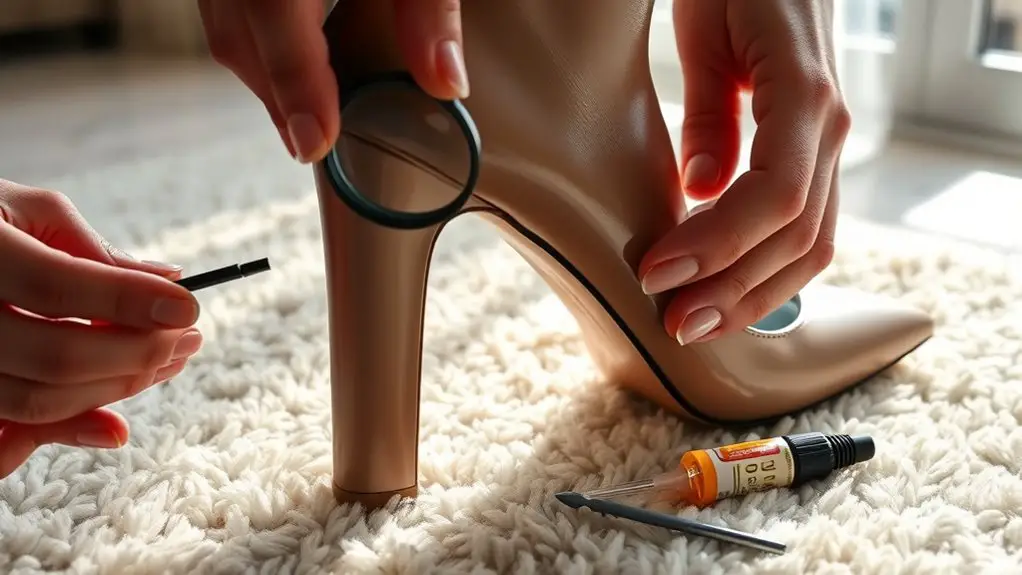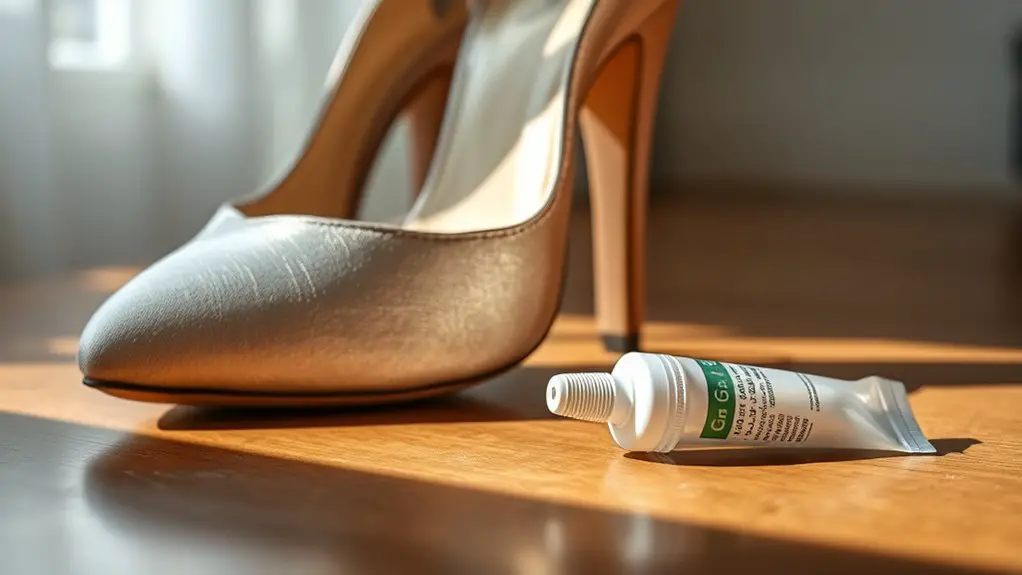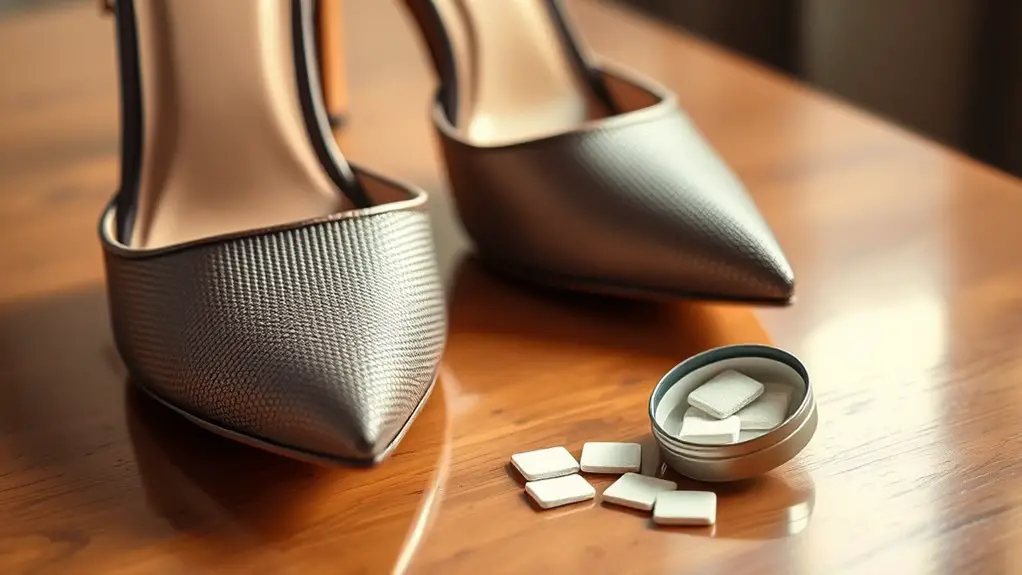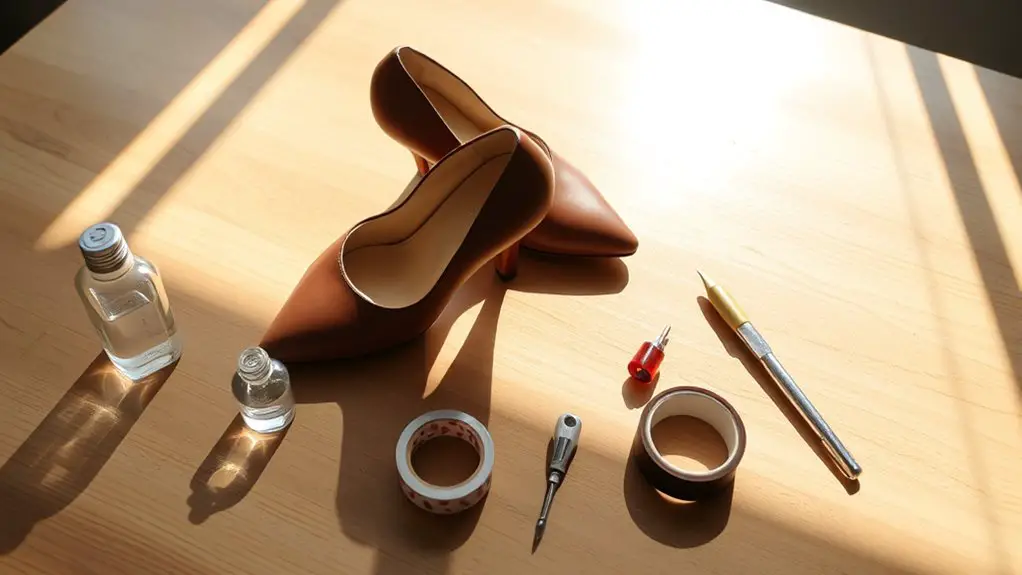To fix wobbly heels at home, start by inspecting the heels for any cracks or excessive wear that could affect stability. Adding heel caps can provide additional support, while shoe glue can secure any loose parts. Adjust the insoles for better weight distribution, and consider using non-slip pads for improved traction. If the problem persists, seeking professional repair might be necessary. There’s more effective methods to explore for maintaining your footwear’s integrity.
Inspect the Heels for Damage

Before you attempt any repairs, it’s essential to inspect the heels for damage. Start by examining the heel material; whether it’s wood, rubber, or plastic, different materials have unique wear patterns that can affect stability. Look for cracks, chips, or significant wear that could compromise the heel’s structural integrity. Pay attention to uneven surfaces, as these can indicate an imbalance that may lead to wobbliness.
Next, assess the wear patterns. If one side of the heel shows more wear, it might indicate improper weight distribution. This can also provide clues about your walking style or posture, which may need addressing to prevent future issues. Document any findings, as this information will guide you in selecting the right repairs. By thoroughly inspecting the heels, you’ll guarantee you’re addressing the root cause of the wobbliness effectively, setting the stage for a successful repair.
Add Heel Caps for Stability
Adding heel caps can greatly enhance stability and extend the life of your shoes. These rubber or plastic components come in various heel cap types, including slip-on, adhesive, and screw-on options. Choosing the right type depends on your shoe design and personal preference.
For heel cap installation, first, clean the heel surface to guarantee a secure bond. If you’re using adhesive caps, apply the glue evenly and press the cap firmly onto the heel. For screw-on caps, align the screws with the pre-drilled holes and tighten them gently to avoid damaging the shoe. Slip-on caps simply need to be pushed onto the heel until they’re snug.
Regularly check the condition of your heel caps, replacing them as needed. This simple addition not only stabilizes your shoes but also improves your overall walking experience, preventing further wobbling issues.
Use Shoe Glue for Loose Parts

If you notice any loose parts on your shoes, using shoe glue can be an effective solution to restore their integrity. Start by selecting a high-quality shoe adhesive designed for the material of your shoes—be it leather, rubber, or fabric. Clean the surfaces thoroughly to guarantee peak adhesion; dirt and dust can weaken the bond. Apply the adhesive evenly to both surfaces, using a small brush or a toothpick for precision. Press the pieces together firmly and hold them in place for the recommended time specified by the manufacturer—this usually ranges from a few seconds to several minutes.
For best results, allow the glue to cure for at least 24 hours before wearing the shoes. This will guarantee a strong bond and reinforce the repair. These simple repair techniques can save you money and extend the life of your footwear, keeping your heels stable and secure.
Adjust the Insoles for Balance
To achieve better balance in your wobbly heels, adjusting the insoles can make a significant difference. Proper insole adjustments help distribute your weight evenly, enhancing stability. Start by removing the existing insoles and checking for wear or unevenness. You may need to replace them with high-quality insoles designed for support and cushioning.
Here’s a quick reference table for effective balance techniques:
| Technique | Description | Benefit |
|---|---|---|
| Arch Support | Add arch supports to enhance foot alignment. | Improves weight distribution. |
| Heel Cups | Use heel cups to cradle your heels. | Reduces heel movement. |
| Layering Insoles | Stack thin insoles for personalized comfort. | Customizes fit for balance. |
Employ Non-Slip Pads for Traction

Adjusting the insoles can enhance stability, but employing non-slip pads adds another layer of support. These pads, made from non-slip materials, can greatly improve traction, reducing the risk of slips and falls. To apply them, first clean the sole of your shoe to guarantee proper adhesion. Then, cut the non-slip pad to fit the heel area, making sure it covers the surface effectively. Press it firmly in place, allowing the adhesive to bond securely.
For peak effectiveness, choose pads designed specifically for footwear, making sure they’re durable enough to withstand wear. Regularly check the condition of these pads; if they show signs of wear or lose their grip, replace them promptly. This simple addition can lead to a noticeable traction improvement, making your shoes feel more secure and stable. By integrating non-slip pads, you’re taking a proactive step towards safer footwear.
Seek Professional Repair if Necessary
Sometimes, DIY fixes aren’t enough, and it’s crucial to know when to seek professional help. Consider the complexity of the repair needed and evaluate the reputation of the repair shop before making a decision. Additionally, factor in the potential costs involved to guarantee it fits within your budget.
When to Seek Help
While many heel issues can be resolved at home, there are instances when seeking professional help becomes necessary. If you notice persistent wobbly symptoms despite your attempts to fix them, don’t hesitate to consult a professional. Here are some scenarios where expert repair is crucial:
- Severe Damage: If the heel structure is broken or considerably compromised.
- Material Complications: When dealing with specialized materials that require specific expertise.
- Persistent Wobbling: If DIY fixes haven’t improved stability within a reasonable repair timeline.
- Safety Concerns: If the heel poses a risk of injury during wear.
In these situations, professional intervention guarantees your heels are restored effectively and safely.
Choosing a Repair Shop
When it comes to selecting a repair shop for your wobbly heels, what should you look for to guarantee quality service? First, consider the repair shop options available in your area. Look for shops that specialize in footwear repair, as they’ll have the expertise needed for your specific issue. Next, inquire about the materials they use; high-quality materials can greatly impact the durability of the repair. Ask if they offer a warranty on their work, which demonstrates confidence in their craftsmanship. Additionally, read customer reviews to assess their reputation and reliability. Finally, consult with the repair technician about your concerns, ensuring they understand the problem and have a clear plan for restoring your heels to their former stability.
Repair Costs to Consider
Repair costs can greatly influence your decision on whether to tackle wobbly heels at home or seek professional help. Before you start, evaluate your repair budget and perform a cost comparison to determine the most economical option. Here are four factors to reflect upon:
- DIY Materials: Basic supplies like glue or replacement heel caps typically range from $5 to $20.
- Professional Repair Fees: Expect to pay anywhere from $30 to $100, depending on the service.
- Time Investment: Contemplate the time you’ll spend on DIY repairs versus the convenience of a professional.
- Long-term Durability: Weigh the benefits of a professional repair’s longevity against your temporary fix.
Ultimately, understanding these costs can guide you in making a sound decision.
Frequently Asked Questions
How Can I Prevent My Heels From Becoming Wobbly in the Future?
To prevent wobbly heels, you’ll need proper heel maintenance tips and effective shoe storage solutions. Regularly check for wear, store shoes upright, and avoid excessive moisture to keep your heels sturdy and reliable over time.
Are There Specific Brands of Shoe Glue Recommended for Repairs?
For shoe repair, consider using strong adhesives like E6000 or Shoe Goo. These adhesive types offer durability and flexibility, guaranteeing your heels stay intact. Always verify surfaces are clean before applying for ideal results.
Can I Use Regular Tape Instead of Non-Slip Pads?
Sure, you could use regular tape, but imagine your heels wobbling like a toddler learning to walk. For proper heel stability, consider non-slip pads or tape alternatives designed specifically for footwear. Your feet will thank you!
What Types of Shoes Are Most Prone to Wobbly Heels?
High-heeled shoes and platform sandals often have narrow bases, making them more prone to wobbly heels. Their design can compromise stability, so it’s essential to choose styles with wider heels or supportive features for better balance.
How Often Should I Check My Heels for Stability?
Think of your heels like a ship at sea; regular stability checks are essential. You should inspect your shoes for heel maintenance every few weeks or after heavy use to guarantee they’re steady and reliable.



